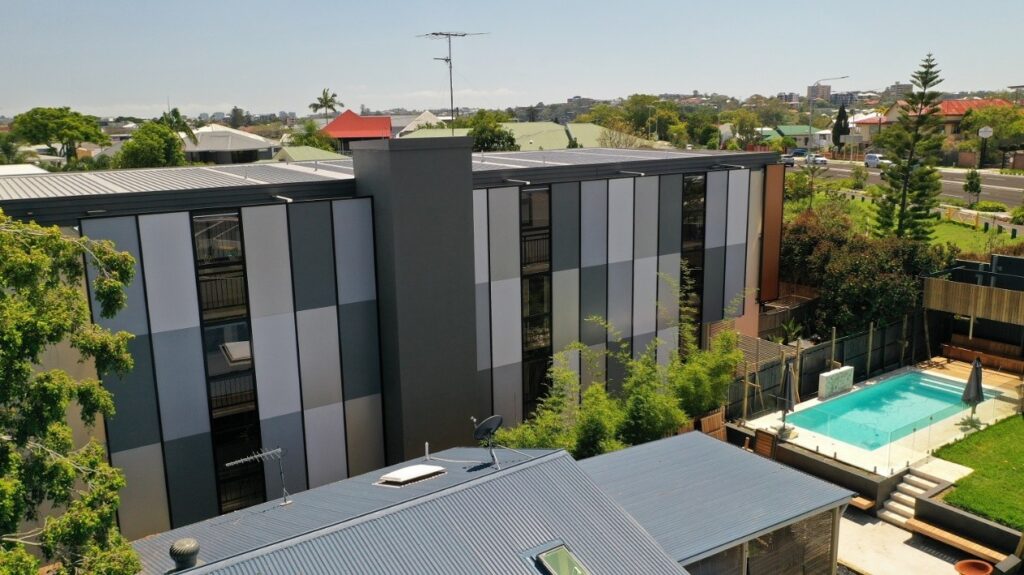In today’s commercial architecture, the integration of innovative shade structures has become a pivotal strategy for enhancing energy efficiency. By mitigating solar heat gain, these structures reduce reliance on artificial cooling systems, leading to significant energy savings. This article delves into the impact of shade structures on energy efficiency, explores various types of shade solutions, and highlights real-world applications, including projects by Versatile Structures.
The Impact of Solar Heat Gain on Commercial Buildings
Solar heat gain refers to the increase in temperature within a space due to solar radiation. In commercial buildings, large windows and expansive glass facades, while aesthetically pleasing, can allow substantial amounts of sunlight to penetrate, leading to elevated indoor temperatures. This necessitates increased use of air conditioning systems, resulting in higher energy consumption and operational costs.
Implementing shade structures can effectively reduce solar heat gain by blocking or filtering sunlight before it enters the building. Studies have shown that well-installed awnings can block up to 80% of heat entering through windows, potentially saving up to 69% in electricity costs, making it a smart investment.
Innovative Shade Solutions for Energy Efficiency
Modern shade structures are designed not only for functionality but also to complement the architectural aesthetics of commercial buildings. Some of the most effective solutions include:
- External Awnings and Blinds: These are installed over windows and can be adjusted to control the amount of sunlight entering the building. By preventing direct sunlight, they significantly reduce indoor temperatures and glare. Studies show that well-installed awnings can block up to 80% of heat entering through windows, leading to substantial energy savings.
- Shade Sails: Made from durable, UV-resistant fabrics, shade sails are versatile and can cover large areas, making them ideal for outdoor spaces like courtyards, parking lots, and recreational areas. By shading these areas, they prevent heat buildup, indirectly contributing to the cooling of adjacent indoor spaces.
- Car Park Shade Structures: Shading parking areas not only protects vehicles but also reduces the heat island effect, where large expanses of asphalt increase surrounding temperatures. This reduction in ambient temperature can decrease the cooling load on nearby buildings. Studies have shown that shaded parking spaces can reduce vehicle interior temperatures by up to 5 degrees celsius, resulting in energy savings of up to 20% for air conditioning.
- Aluminium Sunhoods: These are horizontal or angled structures installed above windows or along facades. They block high-angle sun rays during peak hours while allowing natural light during cooler times, optimizing daylight use and reducing the need for artificial lighting.
Case Studies: Versatile Structures’ Contributions
Versatile Structures has been at the forefront of designing and installing shade solutions that enhance energy efficiency in commercial buildings. Here are a few notable projects:
- Woolworths Logan Reserve: In collaboration with Hutchinson Builders, Versatile Structures transformed the Woolworths Logan Reserve car park with innovative, durable shade structures spanning over 2,300 square meters. These structures not only provide comfort to customers but also reduce heat buildup, contributing to lower energy consumption within the store.
- Logan Village Green: Versatile Structures enhanced Logan Village Green with innovative shade sails designed to stand the test of time. By combining cutting-edge materials and meticulous craftsmanship, they improved both the beauty and durability of this vibrant public space, creating a cooler environment that benefits the surrounding community.
- Stanthorpe Plaza: In the heart of Stanthorpe, Versatile Structures set up a new car park shade structure. This installation not only protects vehicles but also reduces the heat island effect, contributing to a cooler environment for shoppers and reducing the cooling load on the plaza’s indoor spaces.
Design Considerations for Optimal Energy Efficiency
To maximize the energy-saving potential of shade structures, several factors should be considered during the design and installation process:
- Orientation and Placement: Understanding the building’s orientation and the sun’s path is crucial. Shade structures should be positioned to block direct sunlight during peak hours, especially on east and west-facing facades.
- Material Selection: Choosing materials with high UV resistance and reflectivity enhances the structure’s ability to block heat. For instance, fabrics with reflective coatings or light-coloured materials can deflect more sunlight.
- Adjustability: Incorporating adjustable elements, such as retractable awnings or adjustable louvers, allows for flexibility in controlling sunlight and heat gain based on seasonal variations and weather conditions.
- Integration with Building Systems: Integrating shade structures with existing building management systems can optimize performance. For example, automated shades can be programmed to adjust based on indoor temperature readings or time of day.
Conclusion
Innovative shade structures are more than architectural enhancements; they are strategic investments in energy efficiency for commercial buildings. By effectively reducing solar heat gain, these solutions decrease reliance on cooling systems, leading to significant energy savings and improved occupant comfort. As demonstrated by Versatile Structures’ projects, thoughtful design and implementation of shade solutions can transform commercial spaces into sustainable, energy-efficient environments.
Investing in well-designed shade structures not only contributes to immediate energy savings but also aligns with broader sustainability goals, enhancing the building’s value and appeal in an increasingly eco-conscious market.

